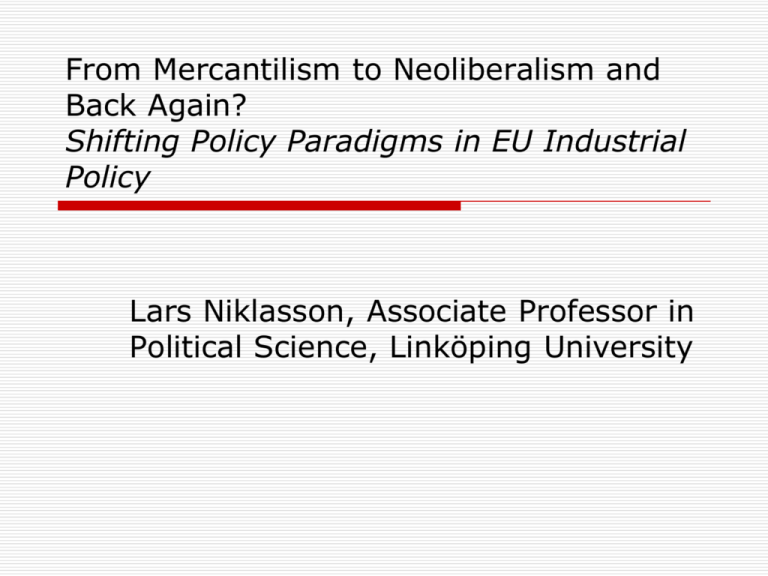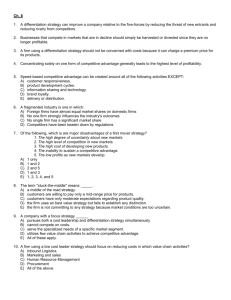National policies to support firms?
advertisement

From Mercantilism to Neoliberalism and Back Again? Shifting Policy Paradigms in EU Industrial Policy Lars Niklasson, Associate Professor in Political Science, Linköping University Contradictory policies? A ”neoliberal” side: ”Creative destruction”, competition Deregulation/common regulation A common currency, restricted gov’t A ”mercantilist” side: Competitiveness, collaboration Support for firms, regions, individuals Eurochampions? Good or bad? Interesting to a political scientist! Why this mix? Where are the political conflicts? What are the motives and ideas? Will this mix produce growth? Is diversity a problem or a strength? Will Europe survive globalization? This overview is a first step A clash of national traditions? National policies to National policies to support firms? support firms? YES/MORE NO/LESS European policies to support firms? YES/MORE France (CEE) European policies to support firms? NO/LESS Germany UK A triangular drama? Liberals Mercantilists Socialdemocrats Pro-market x x (x) Pro-SME x Pro-MNC x (x) Nationalist x (x) Social agenda (x) x Collectivist x x Individualist x (x) COALITIONS: Center-Right x Center-Left Northern x x x x x Oscillating compromises Time Key issue Dominant perspectives 50s-70s Building up industrial policies Mercantilism 80s The Single market Competition Liberalism 90s EMU, SGP ”No industrial policy” ”No innovation policy” (?) Liberalism with some mercantilism Ca 1997-2007 Employment Strategy Mercantilism with some Lisbon Strategy liberalism Ca 2008- Crisis EU 2020 Liberalism with some mercantilism Explanations? External events and crises High level compromises (Thatcher, Mitterand, Kohl) Shifting majorities Business lobbying? (ERT?) DG’s with different perspectives Growing importance of the Parliament Competing paradigms in Economics The underlying conflict: Should diversity be maintained? Policy area UK Germany France Ownership and finance A market of shareholders Coordinated by the banks A dominant role of the state Labor A market for labour, little regulation Regulation and coordination by the social partners Regulated by the state. Unions not so strong R&D Financed by firms and the state Coordinated By the state through and the firms business associations etc MODEL Liberal market economy, LME Coordinated market economy, CME Statedominated CME Mediterranean? A new European compromise? A more social market economy? Model 1 Model 2 Proposed European Social Model The Social Investment State (In use by the EU) The Liberal Investment State Focus Public spending Top-down By agencies Public spending Empowerment Personal accounts Possible coalitions Center-Left: Social democrats + Mercantilists Northern: Social democrats + Liberals Swedish role model The Myrdals on the welfare state 1930s Social partners: ”The comfort of the wings” 1960s Summary and conclusions An interesting contradiction of policies Europe needs SMEs and MNCs A risk that politics is short-sighted and supports existing firms too much Europe needs instruments for skills development and flexibility Better to support individuals than to support firms









